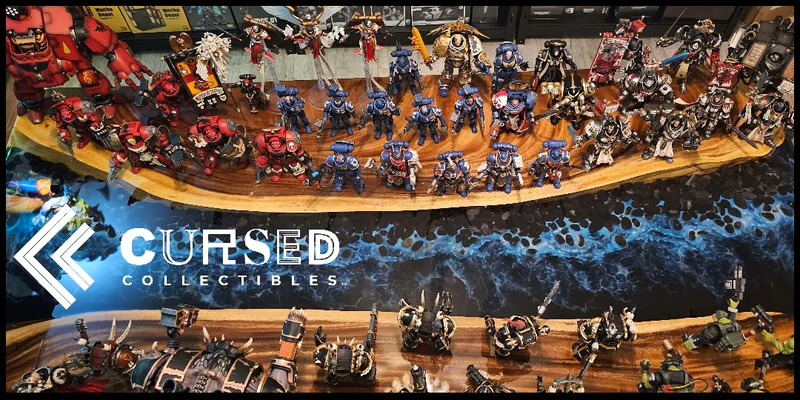Warhammer 40K: A Comprehensive Guide to the Grimdark Universe
Warhammer 40K, or Warhammer 40,000, is a tabletop miniature wargame set in a dystopian science fiction universe. Created by Games Workshop in 1987, it has grown into one of the most iconic franchises in gaming, captivating millions worldwide with its rich lore, diverse factions, and intricate gameplay. This article delves deep into the universe of Warhammer 40K, exploring its history, factions, gameplay mechanics, and cultural impact.
The Origins of Warhammer 40K
Warhammer 40K began as a tabletop game that combined fantasy elements with futuristic settings. Designed by Rick Priestley, the game was a spiritual successor to Warhammer Fantasy Battle. Set in the 41st millennium, Warhammer 40K introduced a universe where endless war defines existence, and every faction fights for survival or domination.
The game’s gothic aesthetic, blending religious iconography with advanced technology, struck a chord with fans. Over the years, it expanded beyond tabletop gaming to include novels, video games, and even an animated series, solidifying its place in pop culture.
The Lore: A Grimdark Universe
At the heart of Warhammer 40K is its lore, often described as “grimdark” due to its bleak and oppressive tone. The universe is set in the 41st millennium, where humanity teeters on the edge of extinction. The Imperium of Man, a vast galaxy-spanning empire, is ruled by the God-Emperor, a figure of immense power and religious significance who remains entombed in the Golden Throne.
The galaxy is rife with conflict, involving numerous factions:
- The Imperium of Man: A militaristic and theocratic empire battling threats from within and beyond.
- Chaos: The forces of the Warp, comprising demonic entities and Chaos Space Marines who seek to corrupt and destroy.
- Xenos Races: Alien factions such as the Orks, Eldar, and Necrons, each with their motives and histories.
The narrative depth of Warhammer 40K is a major draw, offering a grim reflection of human nature and existential struggles.
Key Factions in Warhammer 40K
- The Space Marines
- Known as the Adeptus Astartes, these genetically enhanced super-soldiers are the defenders of humanity. Divided into chapters, each has unique traits and histories, such as the Ultramarines, Blood Angels, and Space Wolves.
- The Astra Militarum (Imperial Guard)
- Ordinary humans forming the backbone of the Imperium’s military might. They rely on sheer numbers and armored vehicles to counter threats.
- Chaos
- Worshippers of the Chaos Gods, these beings represent the dark side of the universe. The Chaos Space Marines, once loyal defenders, turned against the Imperium in the Horus Heresy.
- The Eldar (Aeldari)
- A dying race of ancient, advanced aliens. They use psychic powers and sleek technology to survive against insurmountable odds.
- Orks
- Brutal and humorous, Orks thrive on violence and warfare. Their society revolves around the principle of “might makes right.”
- The Necrons
- Once flesh-and-blood beings, the Necrons are now soulless metal constructs. They seek to reclaim the galaxy from the living.
- The Tyranids
- A swarm of bioengineered organisms driven by an insatiable hunger to consume all life. They are one of the galaxy’s most terrifying threats.
- The T’au Empire
- A young and optimistic faction advocating for the “Greater Good.” They employ advanced technology and diplomacy, contrasting the grim nature of the other factions.
Gameplay Mechanics
Warhammer 40K’s tabletop experience combines strategy, tactics, and creativity. Players build and paint their armies, then battle opponents in scenarios ranging from small skirmishes to large-scale wars. Key mechanics include:
- Army Building: Players choose a faction and assemble a roster of units, each with unique stats and abilities.
- Movement and Combat: Using rulers and dice, players move their miniatures across a battlefield and engage in combat.
- Customization: Personalizing models with unique paint schemes and modifications adds a creative dimension.
The game’s rules evolve with new editions, keeping gameplay fresh and challenging.
Warhammer 40K in Popular Culture
Warhammer 40K has transcended its tabletop origins to become a cultural phenomenon:
- Novels: The Black Library, Games Workshop’s publishing arm, has released hundreds of novels, including the acclaimed Horus Heresy
- Video Games: Titles like Dawn of War, Space Marine, and Darktidebring the Warhammer 40K experience to digital platforms.
- Merchandise: From action figures to apparel, Warhammer 40K offers fans numerous ways to showcase their allegiance.
- Community Events: Tournaments, painting contests, and conventions foster a global community of enthusiasts.
The Art of Miniature Painting
One of the unique aspects of Warhammer 40K is its emphasis on miniature painting. Players take pride in crafting their armies, often spending hours painting intricate details. This aspect of the hobby has spawned a thriving online community, with tutorials, showcases, and competitions dedicated to the art.
The Future of Warhammer 40K
With new editions, expanded lore, and adaptations in various media, Warhammer 40K continues to grow. The upcoming live-action projects, such as the series starring Henry Cavill, promise to bring the universe to an even wider audience.
Conclusion
Warhammer 40K is more than just a game; it’s a gateway to a universe teeming with stories, conflicts, and creativity. Whether you’re a veteran player or a newcomer, the grimdark allure of the 41st millennium offers something for everyone. Dive in, choose your faction, and prepare for war—because in the grim darkness of the far future, there is only war.

